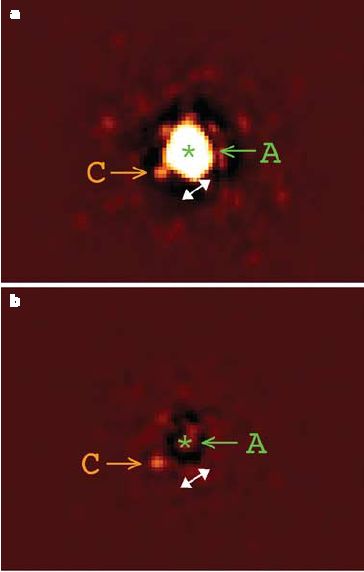Massive Object Calls Planet Discoveries into Question

The first precise measurement of a failed star known as a brown dwarf finds the object is much more massive than theorists expected. The result challenges what astronomers assumed about these strange things, which straddle the mass range between huge planets and normal stars.
If the masses of similar objects have been generally underestimated, then some presumed planets outside our solar system may not be planets after all, astronomers said Wednesday.
The brown dwarf orbits a normal star about 48 light-years from Earth and relatively young at 50 million years old. It was imaged directly in the new study, allowing an accurate determination of its mass. It is at least 88 times as massive as Jupiter, which is nearly twice the heft that conventional thinking called for based on other measurements of the system: The main star wobbles slightly, allowing an estimate for the mass of a presumed companion.
The measurement was led by Laird Close of the University of Arizona and presented in the Jan. 20 issue of Nature.
Brown dwarfs are many times more massive than Jupiter, but they don't have enough material to force a jumpstarting of thermonuclear fusion, the engine that powers a regular star like our Sun.
Astronomers have found about 140 planets outside our solar system. Most are more massive than Jupiter, and some are much more massive. Astronomers have been scrambling to figure out where to draw the line between a giant gas planet and a brown dwarf.
Complicating the matter, several objects that appear to be in the acceptable mass range for planets -- up to about 15 Jupiter masses -- were discovered about five years ago floating freely in space, not bound to any star. Astronomers have been arguing ever since whether these objects are planets or brown dwarfs.
Breaking space news, the latest updates on rocket launches, skywatching events and more!
The brown dwarf is named AB Dor C. It orbits the star AB Doradus A (also called AB Dor A) at a little more than twice the distance between the Earth and the Sun.
Brown dwarfs, especially when they are young, give off heat, which can be detected as infrared radiation. But AB Dor C is 120 times fainter than its host star even in the near-infrared. Close and his European colleagues developed a high-contrast camera on the European Southern Observatory's Very Large Telescope in Chile. The setup uses adaptive optics, which corrects for the blurring effects of Earth's atmosphere to sift through the glare of the main star.
The companion's exact location, along with the star's known wobble, were used to accurately determine the brown dwarf's mass, said team member Jose Guirado of the University of Valencia in Spain.
"Theory predicts that this low-mass, cool object would be about 50 Jupiter masses," Close said. "But theory is incorrect: This object is between 88-98 Jupiter masses. This discovery will force astronomers to rethink what masses of the smallest objects produced in nature really are."
Though just a single observation, the result could have "wide potential ramifications" if other studies yield similar findings, said I. Neill Reid, an astronomer at the Space Telescope Science Institute in Baltimore.
"The supposed objects of 1-2 Jupiter masses might in fact exceed 15-20 Jupiter masses," said Reid, who wrote an analysis of the finding for the journal.
- Free-Floating Planets?
- Likely First Images of Extrasolar Planet
- The Debate over Definitions

Rob has been producing internet content since the mid-1990s. He was a writer, editor and Director of Site Operations at Space.com starting in 1999. He served as Managing Editor of LiveScience since its launch in 2004. He then oversaw news operations for the Space.com's then-parent company TechMediaNetwork's growing suite of technology, science and business news sites. Prior to joining the company, Rob was an editor at The Star-Ledger in New Jersey. He has a journalism degree from Humboldt State University in California, is an author and also writes for Medium.
